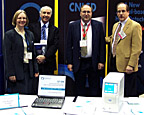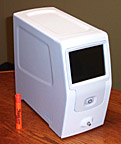March 02, 2007
Chemical compound sensor SIUC researcher's invention now on the market
CARBONDALE, Ill. — John Koropchak sat on the floor poring over old texts at Morris Library. The year was 1991, and Koropchak, then a professor in Southern Illinois University Carbondale's Department of Chemistry and Biochemistry, was looking for ways to improve his research on chemical analysis. As he ingested the literature, Koropchak had what he describes as "that eureka moment" when he envisioned a way to create a new, improved chemical sensor. Koropchak was excited, but as an experienced researcher he knew that not all such moments pan out. A year later, after he and his team completed a successful prototype instrument that utilized his concept, he was more confident that this one would indeed pay off. CARBONDALE, Ill. — John Koropchak sat on the floor poring over old texts at Morris Library. The year was 1991, and Koropchak, then a professor in Southern Illinois University Carbondale's Department of Chemistry and Biochemistry, was looking for ways to improve his research on chemical analysis.As he ingested the literature, Koropchak had what he describes as "that eureka moment" when he envisioned a way to create a new, improved chemical sensor.
Koropchak was excited, but as an experienced researcher he knew that not all such moments pan out. A year later, after he and his team completed a successful prototype instrument that utilized his concept, he was more confident that this one would indeed pay off.
The idea Koropchak and his students developed entered the marketplace this week.
Quant Technologies, a Minnesota-based company, introduced the QT-500 Condensation Nucleation Light Scattering Detector, or CNLSD, during a trade show Monday at the McCormick Place in Chicago. The device, about the size of a large shoebox, is aimed at several technical industries that need extremely accurate chemical compound analysis, including pharmaceuticals, environmental, agriculture, industrial products, life sciences, energy and forensics.
Pat Keady, a business development and marketing official with Quant, said the item is attracting industry attention.
"That's because this really adds a new capability for detection of low concentrations," Keady said. "It's been very exciting. We're getting the attention we anticipated and we're very optimistic."
In introducing the instrument, Quant Technologies acknowledged "the pioneering research work of Professor John Koropchak and his colleagues at SIUC." Keady said Koropchak's idea could have a big impact, especially in pharmaceutical development.
"Really, it's for any industry that needs this (chemical analysis)," she said. "But researchers looking for things like drug purity or degradation, it will really help them refine and purify their products."
Keady said the instrument will also help speed development of new drugs because of its speed, small sample size needed and simplicity. Although many pharmaceutical companies will likely have one centralized mass spectrometry facility for chemical analysis, such companies might eventually own "hundreds" of QT-500s for highly accurate, day-to-day lab work.
Now the vice chancellor for research and the dean of the SIUC graduate school, Koropchak said it is exciting to see a new technology go from the laboratory — in this case, a lab located in the Neckers Building at SIUC — to the market.
"To demonstrate the concept, we spent a lot of time at SIUC perfecting it and testing in all kinds of applications," Koropchak said. "This is a developing, new technology and it's an opportunity for economic development in the United States as we hopefully sell this to other countries. One of the best parts for me is that the undergraduate and graduate students who worked on the project over the years are particularly excited to see their work develop into a successful product."
Although instruments that analyze chemical compounds have been around for decades, Koropchak has adapted a technology previously used for sensing particles in the atmosphere and mated it with another technology, resulting in a new approach so sensitive that in principle it can detect when only a few molecules of a compound are present in a small sample.
The approach first uses a technology known as high performance liquid chromatography (HPLC), which is widely used in chemical analysis to separate mixtures of chemical substances. A detector that separately measures the amount of each substance present then monitors these chemicals.
Current detectors, however, typically have drawbacks, such as lack of sensitivity to small concentrations and/or inability to detect certain types of compounds all together.
Koropchak's approach involves converting the molecules separated by the HPLC into tiny particles that are too small to detect by usual techniques. These particles are used as seeds for condensing a fluid, water in this case, just as 'cloud seeding' is used to stimulate rain. Particles as small as about one nanometer (a billionth of a meter) can be grown into droplets that are big enough (e.g., 10 micrometers) to see even with the naked eye. The difference in mass between the 'seeds' and the final droplets is gigantic, about the difference in size between a grain of sand and the Statue of Liberty—so that it is easy to detect them using a photo detector and lasers.
The result is an instrument that is nearly "universal" in that it can detect virtually any amount or kind of substance, Koropchak said.
"It produces stable, reproducible results and it's a rugged design," Koropchak said.
The National Science Foundation and National Institutes of Health (NIH) funded Koropchak's research over the years. Small-business-innovation-research (SBIR) grants from NIH to Koropchak and David Blackford of Fluid Measurements Technologies Inc. funded the commercialization of the project with Quant as the manufacturer.
Koropchak said he also is working on further upgrades to the process that theoretically could detect single molecules of chemical compounds using extremely tiny sample sizes. Researchers could use such technology to examine, for example, the chemicals present in individual cells.
"If you can get down to the single molecule, that's sort of the holy grail of sensors," Koropchak said. "Our research has shown it may be possible."
Caption: Introducing the product – John Koropchak, far right, vice chancellor for research and dean of the graduate school at Southern Illinois University Carbondale, attends a trade show in Chicago this week where Minnesota-based Quant Technologies introduced the QT-500, a new kind of chemical compound sensor based on his research. Koropchak is shown with, from left, Pat Keady, a business development and marketing official with Quant, David Blackford of Fluid Measurements Technologies Inc. which funded the commercialization of the project, and Frederick R. Quant, president of Quant Technologies.
Photo provided
Caption 2: Extremely reliable, sensative – About the size of a large shoebox, the QT-500 from Quant Technologies is a highly sensitive chemical compound detector with many applications in the pharmaceutical, environmental, agriculture and other high tech industries. The instrument is based around technology developed by John Koropchak, vice chancellor for research and dean of the graduate school at Southern Illinois University Carbondale.
Photo provided


